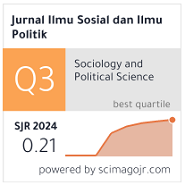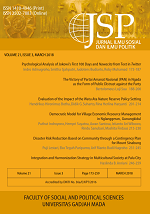Media and Politics: Re-Thinking the Indonesian Broadcasting System
Masduki Masduki(1*)
(1) Department of Communication, Universitas Islam Indonesia
(*) Corresponding Author
Abstract
The emergence of the policy of broadcasting liberalization in the established democracies of Europe and North America, which is indicated by the absence of state intervention to broadcasting governance has been influencing broadcasting policy in the new democracies, including Indonesia. Is it true that Indonesia adopts a liberal broadcasting policy? This paper outlines two issues. First, the academic debate surrounding broadcasting system in the world. Second, discussion as stated by scholars on a thesis of the enactment of the liberal media system in Indonesia that is primarily based on the broadcasting policies after Suharto’s reign of power, among others Law 32/2002 on Broadcasting. Based on the intensive literature review, it can be concluded that the broadcasting system prevailing in Indonesia is not purely liberal, but a mix of liberal and authoritarian model, a unique character that also occurs in the post-communist and post-authoritarian states in Asia, Africa and Eastern Europe. This mix is indicated within the last fifteen years through the adoption of public and community broadcasters and the establishment of Komisi Penyiaran Indonesia (KPI) as an independent regulator that were accompanied with the existing control of the ruling government to public broadcasters (RRI & TVRI); the weak mandate of KPI and the omission of commercial broadcasting domination.
Keywords
Full Text:
PDFReferences
Aliansi Jurnalis Independen. (2016). Laporan Tahunan 2016: Arus Balik Demokrasi, Keberagamaan Diberangus, Kebebasan Ditindas. Jakarta: AJI Indonesia.
Anom, E. (2015). Landasan Kebebasan Media di Indonesia. Jurnal Komunikasi. 12(2), September 2015.
Armando, A. (2016). Televisi Indonesia di Bawah Kapitalisme Global. Jakarta: Gramedia Pustaka Utama.
Chadwick, A. (2013). The Hybrid Media System: Politics and Power. United Kingdom: Oxford University Press.
Curran, J. (2002). Media and Power. London: Routledge
Denzin, Norman K., Lincoln, Chomsky, Noam & Herman, Edward S. (1998). Manufacturing Consent: The Poltical Economy of the Mass Media. Canada: Pantheon Books.
El Richani, S. (2012). Comparing Media System in the West and Beyond. Global Media
Firdaus, A. S. (2012). Past and Present of Siebert & Colleagues’ Four Theories of the Press: Sequential Modifications of Press
Theories Associated with the Media’s Social Obligations within the Framework of the Social Environment of the Press Day.
Malaysian Journal of Media Studies, 14(1), 1-16.
Government Decrees of 12 & 13/2005 on RRI and TVRI
Hallin, D. C., Mancini, P. (2004). Comparing Media System, Three Models of Media and Politics, Cambridge University Press.
Hallin, D. C., Mancini, P. (Ed.). (2012). Comparing Media System, Beyond the Western World. United Kingdom: Cambridge
University Press.
Hardy, J. (2008). Western Media System. United Kingdom: Routledge.
Hidayat, D. N. (2000). Pers dalam Revolusi Mei, Runtuhnya Sebuah Hegemoni. Jakarta: Gramedia Pustaka Utama.
Jakobuwicz, K. (2008). Finding the Right Place on the Map, Central and Eastern European Media Change in a Global
Perspective. United State of America: Intellect Books. Journal, 2(2).
Kristiawan. (2012). Liberalisasi Media, Ekonomi Politik Demokratisasi dan Industrialisasi Media di Indonesia. Unpliblished.
Jakarta: Universitas Indonesia.
Kristiawan. January 14, 2017. Propaganda Lembaga Penyiaran Khusus, Kompas.
Kitley P. (2000). Television, Nation and Culture in Indonesia. Jakarta: Institute for theFree Flow of Information
Law No. 32/2002 on Broadcasting Law No. 400/1999 on Press
Lim, M. (2012). The League of Thirteen, Media Concentration in Indonesia. United States of America: Participatory MediaLab Arizona State University.
Masduki & Darmanto. (2014). Save RRI TVRI, Inisiatif Masyarakat Sipil Mendorong Transformasi LPP di Indonesia. Yogyakarta: Rumah Perubahan LPP.
Masduki. (2007). Regulasi Penyiaran, dari Otoriter ke Liberal. Yogyakarta: Lembaga Kajian Islam dan Sosial.
Masduki. (2014). Media Conglomeration and Political Intervention in the 2014-General Election of Indonesia. GSTF Journal of Media and Communication, 2(1).
McCargo, D. (2012). Partisan Polyvalence: Characterizing the Political Role of Asian Media in Comparing Media System, Beyond the Western World. New York: Cambridge University Press.
McKenzie, R. (2006). Comparing Media, From Around the World. Boston: Pearson Education Inc
McQuail, D. (2013). Investigating the Relation between Media System and Social System. Moscow Readings, November 14-, 15, Russia: Faculty of Journalism, Moscow University.
Mosco, V. (2008). Current Trends in the Political Economy of Communication, Global Media Journal - Canadian Edition, 1(1), 45-63.
Nugroho, Y., Muhammad F. S. & Shita L. (2012). Mapping Media Policy in Indonesia, Jakarta: Center for Indonesian Policy and Governance-Ford Foundation.
Donnell, G., & Philippe C. S. (1986). Transitions from Authoritarian Rule: Tentative Conclusions about Uncertain Democracies. Maryland: Johns Hopkins University Press.
Ostini, J. & Fung, A. (2002). Beyond the Four Theories of the Press: A New Model of National Media System. Journal of Mass Communication and Society 5(1), 41-56.
Pambudi, A., Darmanto, Fajar J., Masduki, Puji R., Olivia LP. & Bonaventura S.(2015). Media Terpenjara, Bayang Bayang Pemilik dalam Pemberitaan Pemilu 2014. Yogyakarta: Masyarakat Peduli Media and Yayasan Tifa.
Rahayu, Bayu, W., Engelbertus W., Iwan, A. Y., Novi, K., Puji R., Wisnu, M. A., & Amir E. S. (2016). Membangun Sistem Komunikasi Indonesia, Terintegrasi, Adaptif, Demokratis. Yogyakarta: PR2Media and Yayasan Tifa.
Rianto, P. (2012). Dominasi Televisi Swasta Nasional dan Krisis Keragaman Kepemilikan dan Isi Siaran. Yogyakarta: Pr2Media & Yayasan Tifa.
Romano, A. (2003). Politics and the Press in Indonesia, Understanding an Evolving Political Culture. London: Routledge.
Romano, A. (2010). ASIA and Public Sentinel, News Media and Governance Reform. Washington DC: The World Bank.
Sekundatmo, Bimo N. (2006). Interaksi Negara, Industri dan Masyarakat Sipil dalam Kontroversi Regulasi Penyiaran. Jakarta: Tesis Master Universitas Indonesia.
Siebert, F., S. Peterson T. & Schramm, W. (1956). Four Theories of the Press. Illinois: University of Illinois Press.
Sudibyo, A. & Patria, N. (2013). The Television Industry in the Post Authoritarian Indonesia. Journal of Contemporary Asia. London: Routledge.
Sudibyo, A. (2004). Ekonomi Politik Media Penyiaran. Yogyakarta: Penerbit LKiS.
Thomson, Mark, (2013), Looking for Shortcuts? Assistance to and Development of PSB in Bosnia Herzegovina, Serbia, Kosovo, Macedonia and Albania. Sarajevo: Centre for Social Research Analitika.
Voltmer, K. (2008). Comparing Media System in New Democracies, East Meets South Meets West. Central European Journal of Communication, 1.
Voltmer, K. (2013). The Media in Transitional Democracies. Cambridge Great Britain: Polity Press.
Winter, Jeffrey A. (2014). Oligarchy and Democracy in Indonesia in Ford, Michele, Pepinsky, Thomas (ed.), Beyond Oligarchy, Wealth, Power, and Contemporary Indonesian Politics, New York: Cornell University.
Article Metrics
Refbacks
- There are currently no refbacks.
Copyright (c) 2017 Jurnal Ilmu Sosial dan Ilmu Politik

This work is licensed under a Creative Commons Attribution-NonCommercial-NoDerivatives 4.0 International License.






















